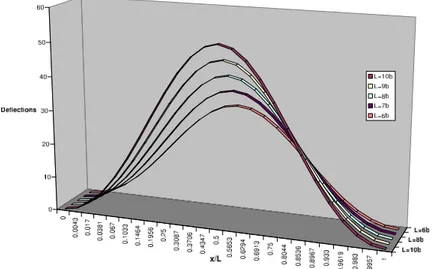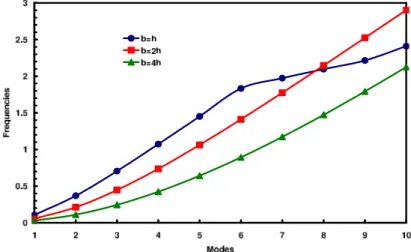Static and free vibration analysis of carbon nano wires based on
Timoshenko beam theory using differential quadrature method
Abstract
Static and free vibration analysis of carbon nano wires with rectangular cross section based on Timoshenko beam theory is studied in this research. Differential quadrature method (DQM) is employed to solve the governing equations. From the knowledge of author, it is the first time that free vibration of nano wires is investigated. It is also the first time that differential quadrature method is used for bending analysis of nano wires.
Keywords
carbon nano wires, Timoshenko beam theory, differential quadrature method, free vibration, static analysis.
Maziar Janghorban∗
Department of Mechanical Engineering, Shiraz Branch, Islamic Azad University, Shiraz, Iran
Received 30 May 2011; In revised form 4 Sep 2011
∗Author email: maziar.janghorban@gmail.com
1 INTRODUCTION
A nano wire (NW) is an extremely thin wire with a diameter on the order of a few nanometers (nm) or less, where 1 nm = 10−9
meters. Nano wires have many interesting properties that are not seen in bulk or 3-D materials. Many different types of nano wires exist, including metallic (e.g., Ni, Pt, Au), semiconducting (e.g., InP, Si, GaN, etc.), and insulating (e.g., SiO2, TiO2).
differential quadrature method. Pradhan and Murmu [13] developed a single nonlocal beam model and applied to investigate the flapwise bending–vibration characteristics of a rotating nano cantilever using DQ method. Murmu and Pradhan [11] also presented the buckling analysis of a single-walled carbon nanotube embedded in elastic medium based on nonlocal elasticity and Timoshenko beam theory and using DQM. In this paper, static and free vibration analysis of carbon nano wires based on Timoshenko beam theory using differential quadrature method is investigated. From the knowledge of author, two kinds of nano wire are exits, one with rectangular cross section and the other with circular cross section. In this study, nano wires with rectangular cross sections are studied.
Figure 1 Structure of nano wires [21].
2 DIFFERENTIAL QUADRATURE METHOD
The numerical solution of partial differential equations plays a considerable role in the areas of engineering. The differential quadrature method is one which can satisfy the above purpose. Differential quadrature is characterized by approximating the derivatives of a function using a weighted sum of functions values on a set of selected discrete points. In order to show the mathematical representations of DQM, consider a function f(x, y) having its field on a rectangular domain 0≤x≤a and 0≤y≤b. let, in the given domain, the function values be
known or desired on a grid of sampling points. According to DQ method, the rth derivative
of a function f(x, y) can be approximated as [2],
∂rf(x, y)
∂xr ∣
(x,y)=(xi,yj) =
N x
∑
m=1
Axim(r)f(xm, yj)= N x
∑
m=1
Axim(r)fmj (1)
where i=1,2, . . . , Nx,j=1,2, . . . , Ny and r=1,2, . . . , Nx−1.
Axij =⎧⎪⎪⎪⎪⎪⎨ ⎪⎪⎪⎪⎪ ⎩
1 Lξ
M(xi)
(xi−xj)M(xj) fori ≠j
−
Nx ∑ j=1
i≠j
Axij fori=j ; i, j =1,2. . . , Nx (2)
where Lx is the length of domain along the x−direction and M(xi)=∏Nk=x1,i≠k(xi−xk).
The weighting coefficients of second order derivative can be obtained as,
[Bijx]=[Ax
ij][A x ij]=[A
x ij]
2
(3)
In a similar way, the weighting coefficients for y-direction can be obtained. The weighting coefficient of the third and fourth order derivatives (Cij, Dij) can be computed easily from
(Bij) by
Cij= N
∑
j=1
AijAijAij, Dij = N
∑
j=1
BijBij (4)
3 GOVERNING EQUATIONS
The importance of shear deformation and rotary inertia in the description of the dynamic response of beams is well documented and an improved theory was given by Timoshenko already in 1921 [20]. Consider a constant thickness nano wire with rectangular cross section with length L, thickness h and width b. In order to calculate the deflections and natural frequencies of carbon nano wires, Timoshenko beam theory is used. The Timoshenko model is an extension of the Euler-Bernoulli model by taking into account two additional effects: shearing force effect and rotary motion effect. For Timoshenko beam theory, the displacement field is assumed to be as follow,
u1=u(x, t)+zθ(x, t), u2=0, u3=w(x, t) (5)
The nonzero strains of the Timoshenko beam theory are [16],
εxx=∂u/∂x+z∂θ/∂x
2εxz=∂w/∂x+θ
(6)
The equations for a Timoshenko beam theory are given by,
∂M/∂x+V =ρI∂2θ/∂t2
∂V/∂x=q(x)+ρA∂2W/∂t2 (7)
M =EI∂θ/∂x
V =kGA(∂W/∂x−θ) (8)
Assuming the sinusoidal motion in time, Eq. (4) yields
KGA(d2W/dx2)−KGA(dθ/dx)+ρAω2W=q(x)
EI(d2θ/dx2)+KGA(dW/dx)−KGAθ+ρIω2θ=0 (9)
Contrary to most other publications, here, these two differential equations of second order are used instead of rearranging these to one differential equation of fourth order. Using the DQ-rules for the spatial derivatives, the DQ-analogs of the governing Eqs. (9) become
KGA⎛ ⎝
N
∑
j=1
BijWi
⎞
⎠−KGA ⎛ ⎝
N
∑
j=1
Aijθi
⎞ ⎠+ρAω
2
Wi=q(xi)
EI⎛ ⎝
N
∑
j=1
Bijθi⎞
⎠+KGA⎛⎝
N
∑
j=1
AijWi⎞
⎠−KGAθi+ρIω 2
θi=0 (10)
Based on Eq. (7) a computer code is developed in MATLAB for static and free vibration analysis. For free vibration analysis, the DQ discretized form of the equations of motion and the related boundary conditions can be expressed in the matrix form as,
Equations of motion: [Kdb] {b}+[Kdd] {d}+[M] {d¨}={0} (11)
Boundary conditions: [Kbb] {b}+[Kbd] {d}={0} (12)
In the above equations,Kdd,Kdb,KbdandKbbrefers to domain-domain, domain-boundary,
boundary-domain and boundary-boundary stiffness matrix, respectively. The mass matrix[M]
is obtained from equations of motion and those of the stiffness matrices [Kii] (i = b, d) are
obtained from the domain and boundary conditions. Solving the eigenvalue system of below equation, the natural frequencies will be obtained.
([KK]−ω2[M]) {X}={0} (13)
Where [KK] = [Kdd]−[Kdb] [Kbb]−1[Kbd]. For static analysis, deflections can easily
calculated from the equation below,
([KK]) {X}={F} (14)
The boundary condition used in this study is defined as,
Simply supported, (at both ends)∶ W =0, ∂2W/∂x2=0 (15)
The discretized form of boundary condition can be obtained by,
Simply supported, (at both ends)∶ Wi=0,
N
∑
j=1
BijWj =0 (16)
Table 1 Comparison of deflections for S-S single walled carbon nanotube with constant thickness under uni-formly distributed load (Do/L=.1,w=wEI/qL4).
Present
[4] [17] Nx=8∗ Nx=10 Nx=12 Nx =14
1.3134 1.3152 1.2562 1.2867 1.3024 1.3115
*Nxis the number of grid points in x direction.
Table 2 Comparison of natural frequencies for S-S single walled carbon nanotube with constant thickness (Do/L=.1,ρ=2300Kg/m3
,E=1000GPa,Do = 33nm,λ2
=ωL2√ρA/EI).
Modes Present Demir [6] Heireche et al [8] Reddy [16] 1 3.1123 3.1405 3.0929 3.1217 2 6.0676 6.2747 5.9399 -3 8.7784 9.3963 8.4444 -4 11.2290 10.7218 10.6260
-5 13.4415 - -
-6 15.4493 - -
-7 17.2847 - -
-8 18.9754 - -
-4 NUMERICAL RESULTS
Let us consider a carbon nano wire having a length L = 400 nm, thickness h=40 nm, width
b= 2h, Young modulus E = 76 GPa [9], densityρ = 1220 Kg/m3
and shear correction factor for rectangular cross section k =5(1+v)/(6+5v) [9]. The moments of inertia and the areas
are calculated using I =(1/12) (bh3) and A=bh. The numerical results can be shown in the
dimensionless quantities defined as follow:
w=w/h, λ2=ωL2√ρA/EI (17)
Figure 2 The effects of width to thickness ratio on the deflections of simply supported carbon nano wires subjected to uniformly distributed loading.
Figure 3 The effects of length to width ratio on the deflections of simply supported carbon nano wires subjected to uniformly distributed loading.
Figure 4 The effects of length to thickness ratio on the deflections of simply supported carbon nano wires subjected to uniformly distributed loading.
deflections of carbon nano wires subjected to uniformly distributed loading are shown in Figs. 2, 3 and 4. One can see that increasing the length to thickness, length to width and thickness to width ratios will increase the deflections of carbon nano wires. The shapes of carbon nano wires under mechanical loading are as we expected and the maximum deflections appear at the middle of nanowire. The convergency of free vibration analysis is studied in Fig. 5. It seems that only nine grid points are enough for investigation of carbon nano wires. It is also shown that for higher modes, more grid points are needed.
Figure 6 The effects of width to thickness ratio on the natural frequencies of simply supported carbon nano wires.
Figure 7 The effects of length to thickness ratio on the natural frequencies of simply supported carbon nano wires.
5 CONCLUSION
Deflections and natural frequencies of carbon nano wires with constant thickness have been obtained by using a Timoshenko beam theory. The differential quadrature method was em-ployed to convert the governing differential equations into a linear system. The accuracy and convergency of present work were investigated. The effects of different parameters are studied, too. Some of the results of present study is,
1. Increasing the length to thickness, length to width and thickness to width ratios will increase the deflections of carbon nano wires.
2. Increase the length to thickness and thickness to width ratios will increase the deflections of carbon nano wires
References
[1] M. Aydogdu. Axial vibration of the nano rods with nonlocal continuum rod model. Physica E, 41:861–4, 2009.
[2] R.E. Bellman and J. Casti. Differential quadrature and long term integration. J. Math. Anal. Appl., 34:235–238, 1971.
[3] ¨O. Civalek and B. Akg¨o¨oz. Static analysis of single walled carbon nanotubes (SWCNT) based on Eringen’s nonlocal elasticity theory.Int. J. Eng. Appl. Sciences, 1:47–56, 2009.
[4] ¨O. Civalek and C. Demir. Bending analysis of microtubules using nonlocal Euler-Bernoulli beam theory. Applied Mathematical Modelling, 2010. In Press.
[5] ¨O. Civalek, C. Demir, and B. Akg¨o¨oz. Free vibration and bending analyses of cantilever microtubules based on nonlocal continuum model. Math. Comput. Appl., 15:289–298, 2010.
[6] C¸ . Demir, ¨O. Civalek, and B. Akg¨o¨oz. Free vibration analysis of carbon nanotubes based on shear deformable beam theory by discrete singular convolution technique.Math. Comput. Appl., 15:57–65, 2010.
[7] Y. Fu and P. Zhang. Buckling and vibration of core-shell nano wires with weak interfaces. Mechanics Research Communications, 37:622–626, 2010.
[8] H. Heireche, A. Tounsi, A. Benzair, M. Maachou, and E.A.D. Bedia. Sound wave propagation in single-walled carbon nanotubes using nonlocal elasticity.Physica E, 40:2791–2799, 2008.
[9] L.Y. Jiang and Z. Yan. Timoshenko beam model for static bending of nano wires with surface effects. Physica E, 42:2274–2279, 2010.
[10] E. Jomehzadeh and A.R. Saidi. Decoupling the nonlocal elasticity equations for three dimensional vibration analysis of nano-plates.Compos Struct, 93(2):1015–20, 2010.
[11] T. Murmu and S.C. Pradhan. Buckling analysis of a single-walled carbon nanotube embedded in an elastic medium based on nonlocal elasticity and Timoshenko beam theory and using DQM. Physica E, 41:1232–1239, 2009.
[12] T. Murmu and S.C. Pradhan. Vibration analysis of nano plates under uniaxial pretressed conditions via nonlocal elasticity. J Appl Phys, 106:104301, 2009.
[13] S.C. Pradhan and T. Murmu. Application of nonlocal elasticity and DQM in the flapwise bending vibration of a rotating nano cantilever.Physica E, 42:1944–1949, 2010.
[14] S.C. Pradhan and J.K. Phadikar. Nonlocal elasticity theory for vibration of nano plates.J Sound Vib., 325:206–23, 2009.
[15] J.R. Quan and C.T. Chang. New insights in solving distributed system equations by the quadrature method – I: Analysis. Comput. Chem. Eng., 13:779–788, 1989.
[17] J.N. Reddy and S.D. Pang. Nonlocal continuum theories of beams for the analysis of carbon nanotubes. J. Appl. Phys., 103:023511, 2008.
[18] C. Shu and B.E. Richards. Application of generalized differential quadrature to solve two-dimensional incompressible Navier-Stokes equations. Int. J. Numer. Meth. Fluids, 15:791–798, 1992.
[19] F. Song and G.L. Huang. Modeling of surface stress effects on bending behavior of nano wires: Incremental defor-mation theory. Physics Letters A, 373:3969–3973, 2009.
[20] S.P. Timoshenko. On the correction for shear of the differential equation for transverse vibrations of prismatic bars.
The London, Edinburgh, and Dublin Philosophical Magazine and Journal of Science, 41(6):744–746, 1921.
[21] ucsdnews.ucsd.edu.
![Figure 1 Structure of nano wires [21].](https://thumb-eu.123doks.com/thumbv2/123dok_br/18884416.423482/2.892.339.604.323.529/figure-structure-of-nano-wires.webp)



